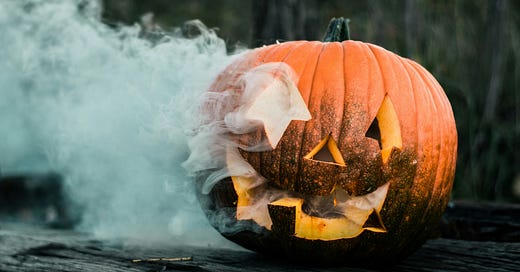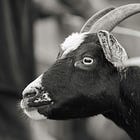I vividly remember my little Scholastic children’s edition of “The Legend of Sleepy Hollow,” filled with earthy autumnal colors and the ghostly grays of the Headless Horseman, burning pumpkin in tow. I was practically galloping in my living room alongside Ichabod Crane as he whipped down the darkened path on that fateful fall night. Two decades later, I still get a little giddy whenever I see the Headless Horseman. The nostalgia’s strong.
Ye Olde Horseman
As a child (and adult) obsessed with animals, you may be surprised to learn that it was the Horseman’s fiery pumpkin head that fascinated me most, rather than his stallion.1 (What can I say? I was never a horse girl.) While the pumpkin symbolizes Washington Irving’s lasting influence on Halloween—taking European customs and implanting a uniquely American bent—horses represent the opposite. Extinct in North America for 10,000 years, colonizers brought horses with them as they sought to transform the western hemisphere into a new Europe. Yet the horses of Irving’s generation looked far different from the ones we know today.
The nineteenth century—with its boom in industrialization—brought a huge demand for horses. With the spread of people across the country, combined with growing urban populations and innovations like steam power and mass transportation, humans became totally reliant on horses’ power to keep civilization running. This caused an increased interest in designing more desirable creatures. Thus began the intensive equine inbreeding of the mid-1800s.
In only a few generations, new species of horses were created. Ann Norton Greene writes in Horses at Work, “The horse population at the beginning of the [nineteenth] century was far more homogenous in size and appearance than it was at the close of the century.” The Thoroughbred became the first recognized “breed” only in 1791, one year after the events of Irving’s short story, and new subspecies like the Percheron, Shire, Clydesdale, and Belgian—with their thick legs and heavy bodies—quickly became popular draft horses in cities and on farms.
A Wannabe Horseman
The horses Ichabod Crane, his rival Brom Bones, and the Headless Horseman rode in the late eighteenth century looked like entirely other beasts from those in modern interpretations of the tale—and modern audiences have also come to know a different protagonist.
In Irving’s story, Ichabod Crane was, frankly, kind of a scumbag. An outsider to Tarrytown, he saw himself as an enlightened intellectual compared to the less-educated townsfolk; this distinction is highlighted in his rivalry with the brawny Brom Bones, a classically handsome and skilled horseman (with strong peaked-in-high-school energy).
Readers understand Ichabod’s intellectualism to be a farce from the kinds of books he enjoys, such as Cotton Mather’s “History of New England Witchcraft.”2 At the time Irving wrote this story (1820), popular fiction nearly always derided women and people of color for falling prey to superstition. An enslaved person may have quaked in their boots at the sound of hoofbeats down a dark road, while the macho white man coolly confronted the danger. In “Sleepy Hollow,” the legend of the Headless Horseman was nothing but an old wives’ tale, indicating that only dotty old ladies spun this yarn.3 Yet Ichabod trembled in terror at the prospect of being out alone at night. He didn’t prescribe to the typical attributes of a leading lad, which ultimately caused him to disappear before he could defeat Brom and win the hand of Katrina Van Tassel. As Adam Jortner says in American Monsters, “Believers in magic and ghosts, it seemed, didn’t deserve to get the girl.”
But Ichabod’s image has been sanitized in other ways, too. The quirky but loveable dork of the 1949 Disney film—aided by the silky timbre of Bing Crosby’s narration—doesn’t quite fit with the original tale’s depiction of a man who fantasized about dead animals:
This fetishization of animals’ soon-to-be-dead bodies speaks to Ichabod’s inflated sense of self-importance. While animals were firmly regarded as inferior beings at this point in history, Ichabod perceived himself as superior to all others, human and nonhuman alike.4
But we know from his actions, like the aforementioned fear of bumps in the night, that this was largely a façade. He likely wanted to impress the lesser townsfolk with his importance by acting like a city slicker. While he could hardly be considered debonair—having no home of his own, he relied on the hospitality of his students’ families for shelter, and fantasized about marrying Katrina so he could sell her family’s farm and move to the city—he certainly wanted others to have that impression.
But his meager means don’t absolve his actions. Like a homophobic bully repressing his own homosexuality, he still contributed to animal suffering regardless of whether or not he truly saw animals solely as the foods they’d one day become. Sure, this was a different time, and not eating animals wasn’t always possible, but he still had full control over how he personally perceived animals. At one point calling the Van Tassels’ guinea hens “ill-tempered housewives,” Ichabod continually demonstrated a lack of empathy for both the women he sought to woo and the animals who died so he could live.5
The Modern Horseman
The Headless Horseman persists among the most iconic Halloween imagery today, alongside pumpkins, witches, and ghosts.6 If you’ve attended a haunted house/theme park this season—or, like me, have watched countless videos of them on YouTube—you may very well have seen decapitated riders trotting about on live horses.
Though there are certainly ethical issues with the way Irving wrote this story—concerning animals, women, and people of color—we can’t hold people of 200 years ago to the ethical standards of today. (I mean, we can, but that seems like wasted energy.) As Nina Nesseth notes in Nightmare Fuel,
“Movies are never created in vacuums. By virtue of being pieced together by real people based on how they view the world around them, films are destined, or doomed, to consciously or subconsciously reflect the filmmakers’ relationships to society and culture.”
She continues by saying that “many filmmakers are unconscious of the way their films are holding up a mirror to the anxieties gripping society at the time when their film is being made.” While the Headless Horseman is more of a cultural icon than a one-off horror flick, the same principle applies.
As animal activists, we see the same prejudice against animals that Ichabod has in the story reflected in modern society. The horses being ridden like soulless machines at haunted houses and hayrides, or even the cheap statues of the Horseman sold in stores like Spirit Halloween, contribute to a broader social acceptance that horses are meant to be used in this way rather than allowed to live free of human influence.
It’s up to us to press on the idiosyncracies in our society that claims to care about animals yet continues to place them in roles of subjugation.
An Evolving Tradition
When I was trying to decide how I wanted to write about “The Legend of Sleepy Hollow,” I cycled through numerous ideas, but none of them worked until I sat down with pen and paper and worked through my feelings about it. The truth is, animal advocates have a tendency to catastrophize about any form of animal use (with good reason), but I just couldn’t find the ire in my heart to get too upset about the Headless Horseman. And while I abhor that actual living horses are being used in our totally unnecessary Halloween celebrations—why isn’t enough for only humans to dress up in scary costumes?—this story is just too special to me to get angry.
Admittedly, there’s also a small part of me that resents the people who can wholeheartedly enjoy this aspect of Halloween Americana, something so foundational to my love of this holiday, and that resents myself for no longer being able to do the same. With most other animal issues—meat, circuses, vivisection—I have no problem calling for their abolition. But I want to keep the Headless Horseman; I just wish we could all enjoy the story while also recognizing that we don’t need to continue perpetuating the abuse in it. That would truly make a happy Halloween.
On my mind: “The Dentist” by Jeff C. Carter
Flash fiction seems so simple. Keeping a story under 1,000 words sounds almost too easy; many novelists write that much, or more, every day. But good flash fiction is significantly harder to find than a good novel. (Arguably, it’s nearly impossible to find.) Every single word must pull its weight, hauling the story through the introduction, middle, climax, and conclusion in only a few hundred words. A good flash fiction story can be nothing less than unforgettable.
Jeff C. Carter made me believe in flash fiction again. His book We Bleed Orange & Black is filled with marvelous short stories and flash fiction, my favorite being “The Dentist” (and my lovely readers may also enjoy “An Attack of Conscience”). I won’t reveal any plot details (the story’s only two pages and the whole book is only 99¢—check it out!), but it’s the perfect little treat to cap off the Halloween season.
I was shocked to learn that there’s no mention of a flaming jack-o’-lantern in the short story. That’s a fabrication from the Disney version.
Contrary to popular belief, Mather was rarely present during the Salem trials, though he wrote extensively on them, thereby inserting himself in the narrative.
Anyone else getting “childless cat lady” vibes?
In fact, some even believed herbivores to be akin to plants themselves, since it was only through the consumption of flesh that one could be considered truly alive.
There are myriad examples like this in the story, such as in the description of Gunpowder, Ichabod’s horse: “The animal he bestrode was a broken-down plow-horse, that had outlived almost everything but its viciousness.”
He’s also spawned countless pumpkin-headed monsters, like those of The Scarecrow Walks at Midnight, Trick ‘r Treat, and the recently discussed Dark Harvest.








